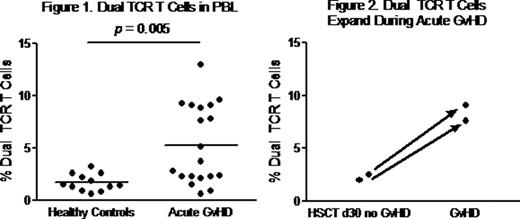Abstract
Abstract 1972
The nature of the T cell repertoire mediating pathologic in vivo alloreactivity is an important question for understanding the development of acute graft-versus-host disease (aGvHD) following clinical allogeneic transplantation. We have previously demonstrated that the small proportion of T cells that naturally express 2 T cell receptors (TCR) as a consequence of incomplete TCRa allelic exclusion during thymic development contribute disproportionately to the alloreactive T cell repertoire, both in vitro and in vivo in a mouse model of graft versus host disease (GvHD) (J. Immunol., 182:6639, 2009). Here, we extend these findings to human biology, examining dual TCR T cells from healthy volunteer donors (n = 12) and patients who have undergone allogeneic hematopoietic stem cell transplantation (HSCT) (n = 19). Peripheral blood was collected at day 30 post-HSCT or at the time of presentation with symptomatic acute GvHD. Dual TCR T cells were measured in peripheral blood by pair-wise staining with 3 commercially-available and 2 novel TCRa mAbs. Dual TCR T cells were consistently and significantly expanded in patients with symptomatic aGvHD, representing 5.3±3.8 % of peripheral T cells, compared to 1.7±0.8 % of T cells in healthy controls (p < 0.005) (Figure 1). There was no correlation between dual TCR T cell frequency and GvHD severity. Furthermore, sequential analysis of peripheral blood in 2 patients demonstrated expansion of dual TCR T cells concurrent with the development of aGvHD (Figure 2). Dual TCR T cells from patients with symptomatic aGvHD demonstrated increased expression of CD69 as compared to T cells expressing a single TCR, indicative of preferential activation of dual TCR T cells during aGvHD. Similarly, dual TCR T cells isolated from patients with symptomatic aGvHD demonstrate increased production of IFN-g ex vivo, indicative of the ability to mediate pathogenic alloreactive responses. Dual TCR T cell clones isolated from healthy donors and patients post-HSCT by single cell FACS sorting demonstrate alloreactive responses against a range of allogeneic cell lines in vitro. We propose that the increased alloreactivity of dual TCR T cells results from the less stringent thymic selection for secondary TCR, and thus provides a link between thymic selection, the TCR repertoire, and alloreactivity. These findings may lead to simple ways of phenotypically identifying specific T cells predisposed to inducing aGvHD for subsequent examination of T cell repertoires and functional studies. Furthermore, these data suggest that dual TCR T cells represent a potential predictive biomarker for aGvHD and a potential target for selective T cell depletion in HSCT.
Disclosures:
No relevant conflicts of interest to declare.
Author notes
*
Asterisk with author names denotes non-ASH members.
© 2011 by The American Society of Hematology
2011


This feature is available to Subscribers Only
Sign In or Create an Account Close Modal